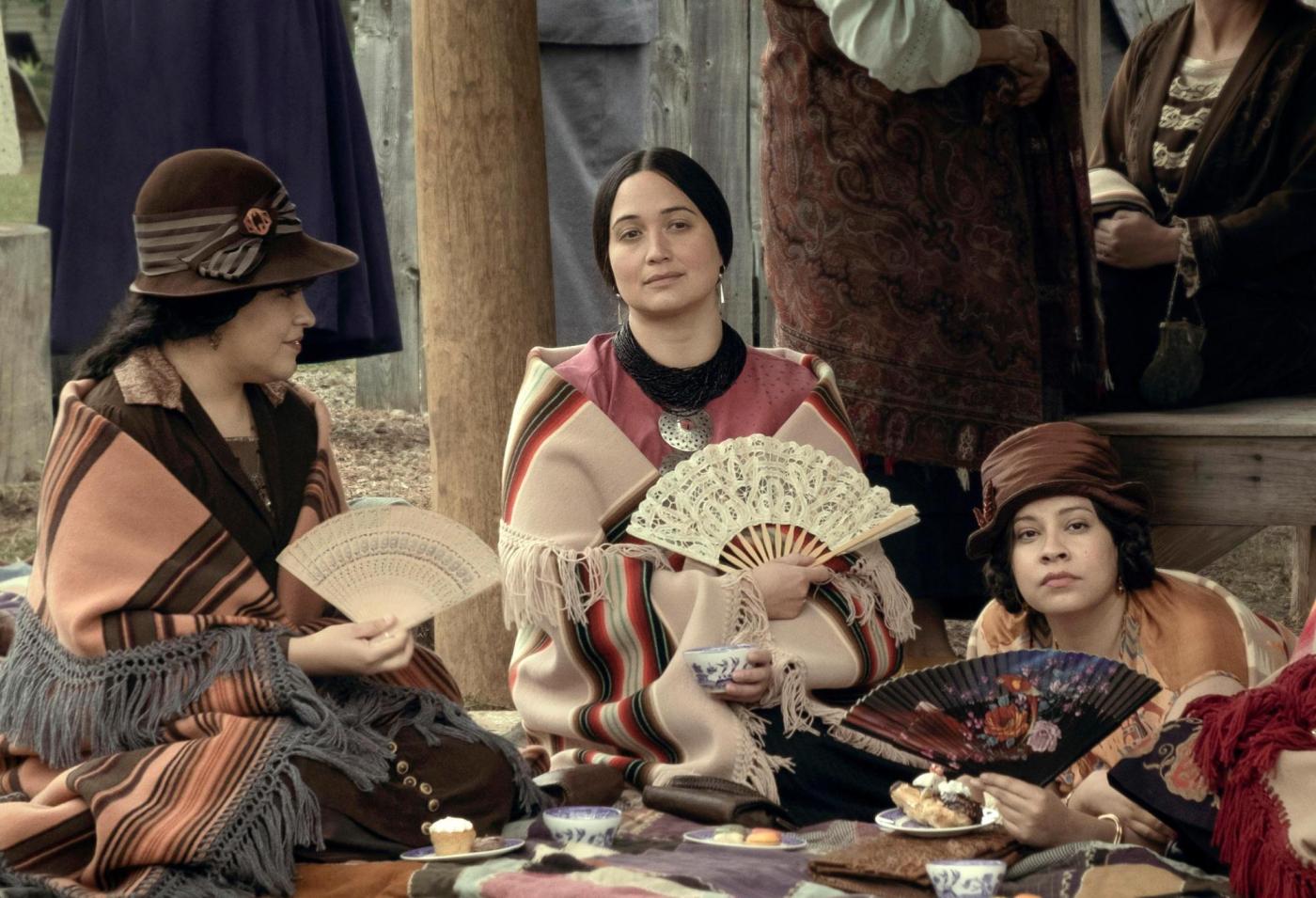
Lily Gladstone’s upset loss to Emma Stone was expected for this reason
When Emma Stone’s name was announced Sunday night as the winner of best actress at the 96th Academy Awards, she looked genuinely stunned, as many pundits had said that Lily Gladstone was the frontrunner and predicted she would make history as the first Native American woman to win an acting Oscar.
But in the run-up to Sunday’s ceremony, some awards watchers were skeptical. They expressed doubt that Gladstone would achieve this historic milestone and not because she didn’t give a superb performance in “Killers of the Flower Moon.”
They cited the issue of Gladstone’s relatively limited screen time in the Martin Scorsese epic crime drama, set in the Osage Nation in the 1920s, and the view that her character, Mollie Burkhart, wasn’t really the film’s narrative focus.
Gladstone, who has a white mother and whose father is of Blackfeet and Nimíipuu heritage, is on screen for about 56 minutes in a film that’s three hours and 26 minutes long, according to Matthew Stewart, a screen timer expert with Gold Derby.
With that 27% screen time, some critics have argued that the film is more interested in the character played by Leonardo DiCaprio, who is on screen for 1 hour and 49 minutes. Gladstone’s limited screen time also sparked debate months ago over whether her role was supporting and she should have campaigned in the supporting actress category.
On the Hollywood industry podcast “The Town” Thursday, host Matthew Belloni and guest Michael Lasker, a talent manager and Oscars expert, agreed that Gladstone had a supporting role. Mollie is an Osage woman whose relatives are systematically being murdered by her husband, played by DiCaprio, and his uncle, played by Robert De Niro, in a bid to seize her family’s oil-rich Oklahoma land.
Belloni and Lasker compared the Mollie character to Stone’s Bella Baxter, whose story is definitely at the center of “Poor Things,” making it more of a traditional leading role.
“I am on record as saying that Emma Stone is going to win,” Belloni said. “It’s a flashier performance.” In Yorgos Lanthimos’ costume drama, Stone plays a woman who goes on a journey of self-discovery after being brought back to life by an eccentric surgeon. She’s on screen for one hour and 37 minutes, or 69% of “Poor Things” running time.
“I think ultimately voters watch the movies, evaluate the performances and select based on what they think is the best performance,” Belloni continued. “There are other factors that come into it. The representation issue, I think, is a big one. (Gladstone) would be the first Native American actress to win in this category. It would be a great moment on stage at the Oscars, and I do think that comes into a little bit.”
Lasker agreed that it would have been a great Oscars moment for Gladstone to win and to give a moving speech on the historic nature of the honor. He also said she was “amazing” in “Killers of the Flower Moon,” though he, too, noted that she’s only in the movie for about 50 minutes.
“It occurred to me: If they had run Lily in supporting, she probably would have run in a landslide,” Lasker said.
Maybe Gladstone would have won in the supporting category, but she would have had stiff competition: Over the course of the 2023 awards season, Da’Vine Joy Randolph was the overwhelming favorite to win that trophy for her performance in “The Holdovers.”
Some people online wondered if the increasingly international makeup of the Academy’s membership could have favored an Emma Stone win. Others expressed concerns that Gladstone’s loss was due to racism and Hollywood’s unwillingness to rectify its “ugly history” of marginalizing and misrepresenting Indigenous people.
For many others, the results of the race revived debate about the narrative intentions of “Killers of the Flower Moon.” As Scorsese and Gladstone promoted “Killers of the Flower Moon,” they, as well as Gladstone fans and some film critics, insisted that her Mollie character was “the moral center” of the film’s narrative.
“If Mollie is the movie’s conscience, Gladstone is its center of gravity: Even when she shares scenes with A-listers like DiCaprio and De Niro, the film bends to her,” New York Times writer Kyle Buchanan wrote in a profile of Gladstone.
A Goldstone fan also posted on X Sunday night: “lily gladstone was the heart and soul of KotFM. the sheer intensity she commanded was astounding. every look, scream, tear, word that came out of her, i felt it in my bones. a performance for the ages in a film that has cemented its place in film history.”
Certainly, Scorsese tried to deflect criticism that he had created another film that focuses on a group of White male antiheroes or on a White male savior. The legendary director explained in interviews that an early version of the screenplay focused on federal agent Tom White, who led the investigation into the Osage murders. DiCaprio originally was cast in the Tom White role. Scorsese and co-writer Eric Roth adapted the script from the book by David Grann, but the script wasn’t working.
“After a certain point, I realized I was making a movie about all the white guys,” Scorsese told Time. “Meaning I was taking the approach from the outside in, which concerned me.”
The script was retooled to examine Mollie and Ernest’s fraught marriage and how racism fuels hatred and greed, NPR reported.
But some said that Scorsese didn’t go far enough in prioritizing Mollie’s perspective, according to NPR. Upon seeing the film at its Los Angeles premiere, Christopher Coté, one of the Osage language instructors brought on to coach the cast, expressed disappointment to The Hollywood Reporter that Mollie wasn’t really at the center of the movie, while acknowledging that its overarching theme is complicity in white supremacy.
Coté said: “Martin Scorsese not being Osage, I think he did a great job representing our people, but this story is being told almost from the perspective of Ernest Burkhart.”
On Sunday night, the Times’ Buchanan defended the choice for Gladstone to campaign in the leading actress category. “There’s more to a film career than winning an Oscar,” he wrote on X. “By going lead, Lily told Hollywood to treat her like a lead. And she just booked another lead, which many supporting winners struggle to do.” But someone responding to Buchanan’s post argued that it would have been “bad optics” for Gladstone to be considered a supporting actor in a story about the Osage Nation while DiCaprio was pushed as a lead actor.”
Gladstone’s supporters could argue that she had as much right to campaign for a leading acting Oscar as Anthony Hopkins did in 1991, when he won best actor for his 16 minutes of screen time as Hannibal Lecter in “The Silence of the Lambs.” Meanwhile, as her fans expressed disappointment that she didn’t win the Oscar, they said her nomination itself was historic. As the Washington Post reported, Gladstone’s season was “trailblazing,” with her racking up Golden Globe and Screen Actors Guild awards. She also received a standing ovation when she won the SAG award last month.
Some cultural commentators also spoke of the “Lily Gladstone effect,” how her high profile this awards season, standing at podiums to accept multiple honors, would help lift up other Native talent in the industry, the Christian Science Monitor reported.
“Lily Gladstone not winning does not take away from the fact that she gave one of the best performances of the year,” said Variety editor Jazz Tangcay on X. “Her performance and the film will live on long after tonight is over. Her wins have been historic and trailblazing. She already made history.”
Related Articles
How Kacey Musgraves opened herself back up to love
‘Nolly’ review: On Masterpiece, Helena Bonham Carter plays a soap star who’s been sacked
Calling all ‘Top Chef’ nerds: Here are 6 more ways to feed your inner foodie
What to watch: Kristen Stewart sizzles in wild ‘Love Lies Bleeding’
St. Patrick’s Day Parades land on Saturday, not Sunday, and other tips o’ the Irish to keep in mind

